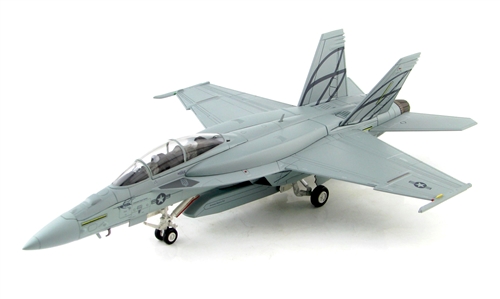Hobby Master Boeing F/A-18F Block III Advanced Super Hornet Strike Fighter
Hobby Master Boeing F/A-18F Block III Advanced Super Hornet Strike Fighter
 Boeing and Northrop Grumman self-funded a prototype of the Advanced Super Hornet in the early 2010s. The prototype features a 50% reduction in frontal radar cross-section (RCS), conformal fuel tanks (CFT), and an enclosed weapons pod. Features could also be integrated onto the EA-18G Growler; using CFTs on the EA-18 fleet was speculated as useful to releasing underwing space and drag margin for the Next Generation Jammer. Flight tests of the Advanced Super Hornet began on August 5th, 2013, and continued for three weeks, testing the performance of CFTs, the enclosed weapons pod (EWP), and signature enhancements. The U.S. Navy was reportedly pleased with the Advanced Super Hornet's flight test results, and hopes it will provide future procurement options.
Boeing and Northrop Grumman self-funded a prototype of the Advanced Super Hornet in the early 2010s. The prototype features a 50% reduction in frontal radar cross-section (RCS), conformal fuel tanks (CFT), and an enclosed weapons pod. Features could also be integrated onto the EA-18G Growler; using CFTs on the EA-18 fleet was speculated as useful to releasing underwing space and drag margin for the Next Generation Jammer. Flight tests of the Advanced Super Hornet began on August 5th, 2013, and continued for three weeks, testing the performance of CFTs, the enclosed weapons pod (EWP), and signature enhancements. The U.S. Navy was reportedly pleased with the Advanced Super Hornet's flight test results, and hopes it will provide future procurement options.
In March 2013, the U.S. Navy was considering the widespread adoption of conformal fuel tanks, which would allow the Super Hornet to carry 3,500 lb (1,600 kg) of additional fuel. Budgetary pressures from theF-35C Lightning II and Pacific region operations were cited as reasons supporting the use of CFTs. Flight testing demonstrated CFTs could slightly reduce drag while expanding the combat range by 260 nautical miles (300 mi; 480 km). The prototype CFT weighed 1,500 lb (680 kg), while production CFTs are expected to weigh 870 lb (390 kg). Boeing stated that the CFTs do not add any cruise drag but acknowledged a negative impact imposed on transonic acceleration due to increased wave drag. General Electric's enhanced performance engine (EPE), increasing the F414-GE-400's power output from 22,000 to 26,400 lbf (98 to 117 kN) of thrust per engine, was suggested as a mitigating measure. In 2009, development commenced on several engine improvements, including greater resistance to foreign object damage, reduced fuel burn rate, and potentially increased thrust of up to 20%.
In 2014, Boeing revealed a Super Hornet hybrid concept, equipped with the EA-18G Growler's electronic signal detection capabilities to allow for targets engagement using the receiver; the concept did not include the ALQ-99 jamming pod. Growth capabilities could include the addition of a long-range infrared search and track sensor and new air-to-air tracking modes.
In September 2014, Boeing readied plans to close its St. Louis production lines for the Super Hornet and F-15 in 2017. Chris Chadwick, president of Boeing Defense, Space and Security, told the Wall Street Journal that, although "we're still solidly behind them," the company could have decided by April 2015 whether to shut down both assembly lines and close the factory, but chose to keep the Super Hornet line going. Due to various Pentagon contracts, Boeing had enough orders to keep things running into 2017 to give Boeing the opportunity to firm up more international orders.
#HA5118 - US Navy Boeing F/A-18F Block III Advanced Super Hornet Strike Fighter - 168492, Boeing Testing Facility, St. Louis, Missouri, 2013 [Low-Vis Scheme] (1:72 Scale)
|





 Boeing and Northrop Grumman self-funded a prototype of the Advanced Super Hornet in the early 2010s. The prototype features a 50% reduction in frontal radar cross-section (RCS), conformal fuel tanks (CFT), and an enclosed weapons pod. Features could also be integrated onto the EA-18G Growler; using CFTs on the EA-18 fleet was speculated as useful to releasing underwing space and drag margin for the Next Generation Jammer. Flight tests of the Advanced Super Hornet began on August 5th, 2013, and continued for three weeks, testing the performance of CFTs, the enclosed weapons pod (EWP), and signature enhancements. The U.S. Navy was reportedly pleased with the Advanced Super Hornet's flight test results, and hopes it will provide future procurement options.
Boeing and Northrop Grumman self-funded a prototype of the Advanced Super Hornet in the early 2010s. The prototype features a 50% reduction in frontal radar cross-section (RCS), conformal fuel tanks (CFT), and an enclosed weapons pod. Features could also be integrated onto the EA-18G Growler; using CFTs on the EA-18 fleet was speculated as useful to releasing underwing space and drag margin for the Next Generation Jammer. Flight tests of the Advanced Super Hornet began on August 5th, 2013, and continued for three weeks, testing the performance of CFTs, the enclosed weapons pod (EWP), and signature enhancements. The U.S. Navy was reportedly pleased with the Advanced Super Hornet's flight test results, and hopes it will provide future procurement options.